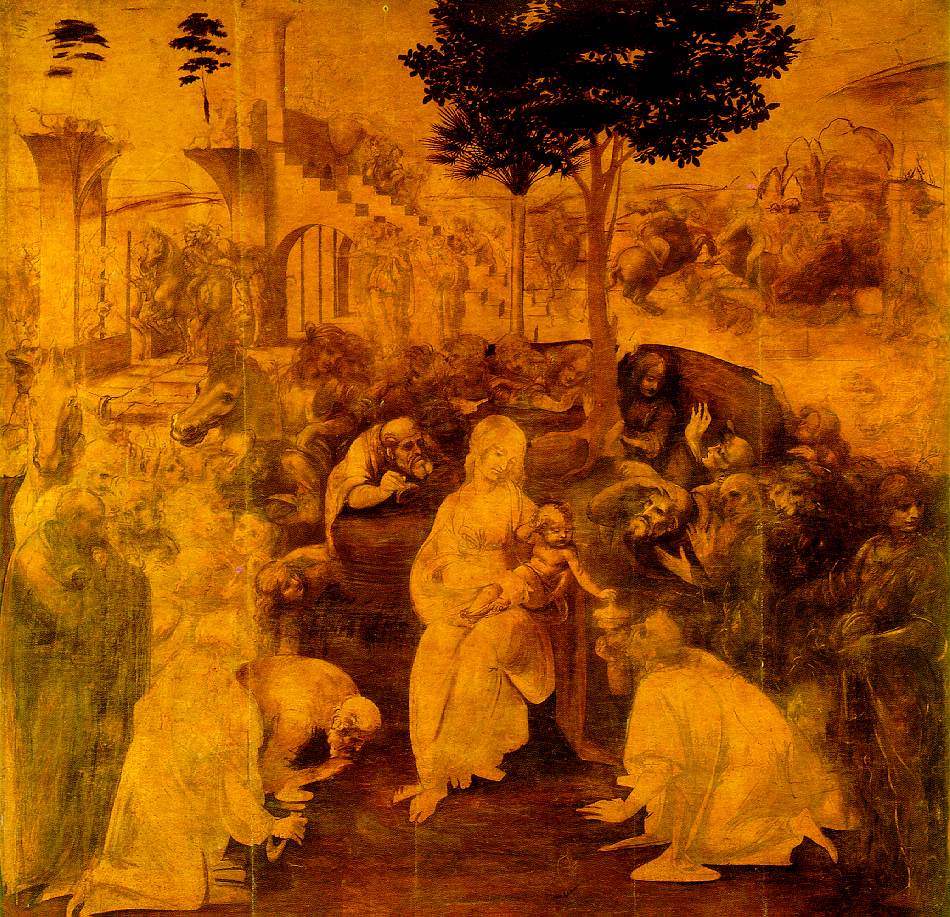 Perspectival study for The Adoration of the Magi, c. 1481
Perspectival study for The Adoration of the Magi, c. 1481Study for The Adoration of the Magi, 1478–1481
 Study for The Adoration of the Magi, 1478–1481
Study for The Adoration of the Magi, 1478–1481  Adoration of the Magi Leonardo da Vinci, 1481
Adoration of the Magi Leonardo da Vinci, 1481The Adoration of the Magi is an early painting by Leonardo da Vinci. Leonardo was given the commission by the Augustinian monks of San Donato a Scopeto in Florence, but departed for Milan the following year, leaving the painting unfinished. It has been in the Uffizi Gallery in Florence since 1670.
The Virgin Mary and Child are depicted in the foreground and form a triangular shape with the Magi kneeling in adoration. Behind them is a semicircle of accompanying figures, including what may be a self-portrait of the young Leonardo (on the far right). In the background on the left is the ruin of a pagan building, on which workmen can be seen, apparently repairing it. On the right are men on horseback fighting, and a sketch of a rocky landscape.
The ruins are a possible reference to the Basilica of Maxentius, which, according to Medieval legend, the Romans claimed would stand until a virgin gave birth. It is supposed to have collapsed on the night of Christ's birth (in fact it was not even built until a later date). The ruins dominate a preparatory perspective drawing by Leonardo, which also features the fighting horsemen, but were relegated to the background in the final painting. The palm tree in the centre has associations with the Virgin Mary, partly due to the phrase 'You are stately as a palm tree' from the Song of Solomon, which is believed to prefigure her. Another aspect of the palm tree can be the usage of the palm tree as as a symbol of victory for ancient Rome, whereas in Christianity it is a representation of martyrdom--triumph over death-- so in conclusion we can say that the palm in general represents triumph. The other tree in the painting is from the carob family, the seeds from the tree are used as a unit of measurement. They measure valuable stones and jewels. This tree and its seeds are associated with crowns suggesting Christ as the king of kings or the Virgin as the future Queen of heaven, also that this is nature's gift to the new born Christ. As with Michelangelo's Doni Tondo the background is probably supposed to represent the Pagan world supplanted by the Christian world, as inaugurated by the events in the foreground.
Leonardo develops his pioneering use of chiaroscuro in the image, creating a seemingly chaotic mass of people plunged into darkness and confusion from which the Magi peer towards the brightly lit figures of Mary and Jesus, while the pagan world in the background carries on building and warring unaware of the new revelation.
Due to Leonardo's inability to complete the painting the commission was handed over to Domenico Ghirlandaio. The final altarpiece was painted by Filippino Lippi and is now also at the Uffizi.
In 2002 Maurizio Seracini, a technical specialist on art diagnostic, was commissioned by the Uffizi to undertake a study of the paint-surface to determine whether the painting could be restored without damaging it. He concluded that it could not and he argued that only the underdrawing was done by Leonardo da Vinci, the paint surface having been added by another, weaker, artist. He stated that "none of the paint we see on the Adoration today was put there by Leonardo". To demonstrate the results of his diagnostic survery on the Adoration of the Magi, Seracini completed more than 2400 detailed infrared photographic records of the painting's elaborate underdrawing, and scientific analyses. Many art historians are currently unconvinced by Seracini's interpretation of his own results.
The painting is the central item in the Andrei Tarkovsky's final film The Sacrifice.(from wikipedia)
没有评论:
发表评论